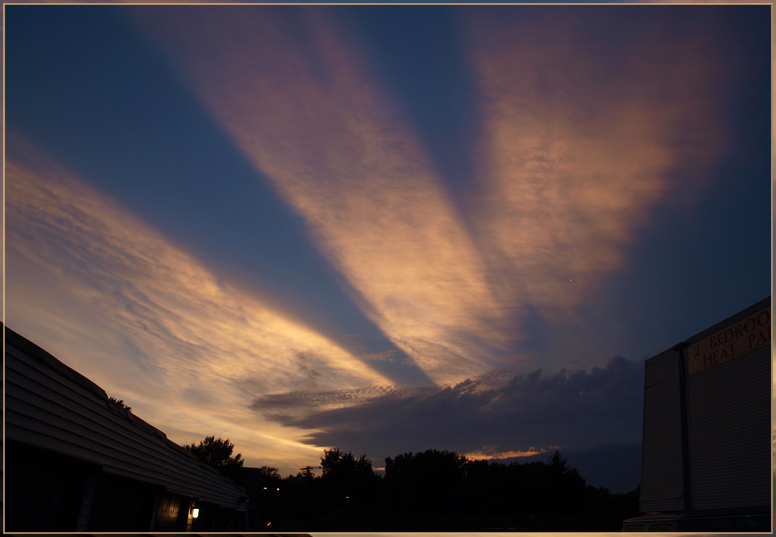Sun & Antisun Rays
Sun & Antisun Rays: A Fascinating Display of Atmospheric Optics
Have you ever witnessed a breathtaking display of rays converging towards the sky? These captivating phenomena, known as sun and antisun rays, can leave you in awe of the wonders of the atmosphere. In this article, we will delve deeper into the science behind these optical marvels and explore their mesmerizing characteristics.
The Enigmatic Convergence of Shadows
When observing the sky during sunrise or sunset, you may notice long, bluish shadows crossing the heavens and seemingly converging at a point opposite the position of the sun. These shadows create a stunning effect that adds a touch of mystery to the atmosphere. However, there's a fascinating explanation behind this apparent convergence.
Although it may appear as though these shadows are converging towards a single point, they are actually parallel. This optical illusion is due to perspective, tricking our eyes into perceiving convergence. Thus, while the shadows give the impression of meeting at a specific spot, they remain parallel throughout their journey across the sky.
Introducing Antisolar Rays
While commonly referred to as anticrepuscular rays, a more descriptive term for these captivating phenomena is "antisolar rays." Unlike their name suggests, these rays are not against twilight but rather originate from the antisolar point. The antisolar point is directly opposite the sun's position in the sky. Therefore, when witnessing these rays, you are actually observing sunlight scattering off particles or clouds located at the antisolar point.
Shadows Cast by Clouds
The lower image in the provided visuals showcases shadows cast by banked clouds near or beyond the horizon. These cloud shadows add an additional layer of intrigue to the atmospheric display. Most cloud shadows we encounter in our daily lives are three-dimensional, resembling long tubes of unlit air. However, in this scenario, the shadows take on a two-dimensional form as they are cast upon and along a cloud layer.
The intensity of these shadows can be attributed to the unique conditions present. When the clouds are banked low on the horizon or beyond it, the angle of the sunlight interacting with the clouds creates a striking effect. As a result, the shadows appear more pronounced and captivating to the observer.
Exploring the Wonders of Atmospheric Optics
Sun and antisun rays are just one example of the captivating phenomena that atmospheric optics has to offer. The atmosphere is a canvas for nature's light show, where various factors interact to create breathtaking displays. From rainbows and halos to iridescent clouds and mirages, the study of atmospheric optics uncovers a world of wonder.
To fully appreciate and understand these natural wonders, it is crucial to delve into the underlying scientific principles. Factors such as light scattering, refraction, and reflection play vital roles in shaping the appearance of these optical phenomena. By exploring these principles, we gain insight into how our atmosphere interacts with light, creating mesmerizing displays for us to marvel at.
Embracing the Beauty of Nature's Light Show
Witnessing sun and antisun rays is a testament to the beauty and complexity of our natural world. These optical phenomena remind us of the intricacies hidden within our atmosphere, waiting to be uncovered and appreciated. The convergence of shadows and the interplay between light and particles or clouds create an enchanting spectacle that leaves us in awe.
Next time you find yourself gazing at the sky during sunrise or sunset, take a moment to appreciate the dance of light and shadow unfolding above you. The beauty of atmospheric optics is a constant reminder that even in the ordinary, there is extraordinary beauty waiting to be discovered. So, embrace the wonders of nature's light show and let yourself be captivated by the ever-changing canvas of the sky.

Sun & Antisun
Anticrepuscular and crepuscular rays of startling intensity imaged by Jim Niebur at Omaha, Nebraska. ©Jim Niebur

The top image looks eastwards away from the sunset point. The sun was just setting at ground level but still above the horizon higher up and illuminating the clouds.
Long bluish shadows cross the sky to apparently converge at the antisolar point directly opposite the sun. The shadows are in reality nearly parallel and only seem to converge by perspective.
'Antisolar' might be a more descriptive name for these rays rather than anticrepuscular implying that they are against the twilight.
The lower image looks sunwards. The shadows are cast by banked clouds low on the horizon or beyond it.
Most cloud shadows are three dimensional in the sense that they are long tubes of unlit air. Here they are probably two dimensional shadows cast upon and along a cloud layer - Hence their intensity.
Note: this article has been automatically converted from the old site and may not appear as intended. You can find the original article here.
Reference Atmospheric Optics
If you use any of the definitions, information, or data presented on Atmospheric Optics, please copy the link or reference below to properly credit us as the reference source. Thank you!
-
<a href="https://atoptics.co.uk/blog/sun-antisun-rays/">Sun & Antisun Rays</a>
-
"Sun & Antisun Rays". Atmospheric Optics. Accessed on November 26, 2024. https://atoptics.co.uk/blog/sun-antisun-rays/.
-
"Sun & Antisun Rays". Atmospheric Optics, https://atoptics.co.uk/blog/sun-antisun-rays/. Accessed 26 November, 2024
-
Sun & Antisun Rays. Atmospheric Optics. Retrieved from https://atoptics.co.uk/blog/sun-antisun-rays/.